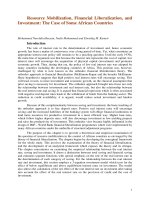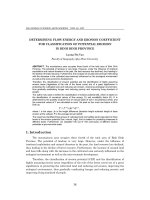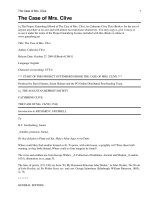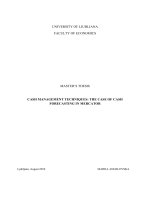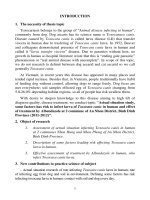The happiness of vietnamese micro analysis of happiness determinants in the case of binh dinh province
Bạn đang xem bản rút gọn của tài liệu. Xem và tải ngay bản đầy đủ của tài liệu tại đây (1.64 MB, 86 trang )
UNIVERSITY OF ECONOMICS
INSTITUTE OF SOCIAL STUDIES
HO CHI MINH CITY
THE HAGUES
VIETNAM
THE NETHERLANDS
VIETNAM – NETHERLANDS
PROGRAMME FOR M.A IN DEVELOPMENT ECONOMICS
THE HAPPINESS OF VIETNAMESE: MICRO-ANALYSIS
OF HAPPINESS DETERMINANTS IN THE CASE OF
BINH DINH PROVINCE
A thesis submitted in partial fulfilment of the requirements for the degree of
MASTER OF ARTS IN DEVELOPMENT ECONOMICS
By
HO DAI NGHIA
Academic Supervisor:
Dr. TRAN ANH TUAN
HO CHI MINH CITY, AUGUST 2013
i
Acknowledgements
During the time of studying in Vietnam – Netherlands programme for Master of
Arts in Developing Economics, I have learned so much helpful knowledge.
Therefore, I would like to thank to Programme and all the teachers that have
taught me in this time.
I would like to express the deepest appreciation to my research supervisors, Dr.
Anh Tuan, for his patient guidance, industrious encouragement and fruitful
critiques of this research work. Besides my supervisor, I want to acknowledge
the tremendous support that I received from Dr. Pham Khanh Nam and Prof. Dr.
Nguyen Trong Hoai for giving me constructive comments and warm
encouragement.
I would like to offer my special thanks to many friends at People's Committee of
Binh Dinh for your assistance and helpful advice with the eye glance data
reduction process. Without your guidance and persistent help this thesis would
not have been possible. I am particularly grateful for the assistance given by the
officer of my university’s library for his help in offering me the resources in
researching and performing the program.
Lastly, the most special thanks go to my best partner and friend, my father, for
his help in collecting the data analysis and other helpful things. My gratitude
also goes to my mother. She gave me your unconditional support through all this
long process.
ii
Abstract
Although economic growth is higher in many countries, these nations still have
no increase or even suffering a depression in average national happiness. This
study has carefully examined the determinants of happiness or subject wellbeing from literature. These determinants are divided into three main categories:
economic determinants, personal and demographic determinants and, finally,
social determinants. In addition to, some recent evidence reveal that happiness
also has the adverse significant effect on these factors and economic growth only
has restricted effects on happiness level of particular nations. In specific case,
based on 300 observations and ONS approach, this research paper desires to
estimate the magnitude of determinants of happiness in Binh Dinh province at
individual level. The results reveal that the mental, physical health, local
facilities satisfaction and household income have strong effects on individual’s
happiness level with high statistical significance. Furthermore, the size of
coefficients other several variables, including being a female, having partner,
high qualification, owned-house status, being employed or living in city is small
and ambiguous. It means that they have weak relationships with the happiness
level. Specifically, two variables of age and be employed, have opposed sign as
literature.
Keywords: Subject well-being, Happiness, Economic Growth, Life Satisfaction,
Determinants, Binh Dinh Province.
iii
Table of Contents
Acknowledgements .................................................................................................. ii
Abstract ................................................................................................................... iii
List of Tables .......................................................................................................... vi
List of Figures ........................................................................................................ vii
Abbreviations ........................................................................................................ viii
Introduction .............................................................................................................. 1
Chapter One: Literature Review .......................................................................... 5
1.1. Happiness notation .........................................................................................5
1.1.1. Well-being concept ................................................................................. 5
1.1.2. Object and subject well-being ................................................................ 6
1.1.3. Three dimensions theory ........................................................................ 7
1.1.4. Conceptual framework ......................................................................... 10
1.2. Determinants of Happiness ..........................................................................11
1.2.1 Happiness and Income ........................................................................... 11
1.2.2 Happiness and Unemployment .............................................................. 19
1.2.3 Happiness and Inequality....................................................................... 23
1.2.4 Happiness and Demographic Determinants .......................................... 24
1.2.5. Happiness and Social Determinants ..................................................... 31
Chapter two: Socio-economic Overview of Binh Dinh province .................….33
2.1. Overview of Economics factors ...................................................................33
2.2. Contribution to happiness at glance .............................................................34
2.3 Some remained obstructions .........................................................................37
Chapter Three: Methodology and Data............................................................. 39
3.1. Data ..............................................................................................................42
3.1.1 Data description ..................................................................................... 42
3.1.2 The questionnaire design- ONS approach ............................................. 42
3.2. Methodology ................................................................................................46
iv
3.2.1. Model specification .............................................................................. 46
3.2.2. The research detail function ................................................................. 44
3.2.3. Hypothesis statement ............................................................................ 49
3.2.4. The description of variables use in this research .................................. 49
Chapter 4: Analysis result ................................................................................... 53
4.1. The empirical analysis..................................................................................53
4.1.1. Multicolinearity test .............................................................................. 53
4.1.2. Heteroscedasticity test .......................................................................... 53
4.2. Analysis result ..............................................................................................53
4.3. Analysis examination ...................................................................................55
4.3. 1. Demographics determinants ................................................................ 55
4.2.2. Education and health determinants ....................................................... 56
4.2.3. Economic and work determinants ........................................................ 58
4.2.4. Social life and community relationships determinants ......................... 59
Chapter 5: Conclusion and ruture research directions .................................... 62
5.1. Conclusion and Recommendation................................................................62
5.2. Limitation and future research directions ....................................................65
APPENDICE ........................................................................................................ 53
Reference............................................................................................................... 73
v
List of Tables
Table 1-The description of variables use in the thesis
Table 2 - Literature findings on determinants affecting happiness level
Table 3- Breusch-Pagan-Godfrey test result
Table 4- WLS and OLS analysis result
Table 5- Coefficients sign comparison
vi
List of Figures
Figure 1- Three dimensions of well-being
Figure 2- Conceptual framework
Figure 3- GDP per capita and happiness across regions
Figure 4- Happiness and Income in USA
Figure 5- Happiness and Income in Japan
Figure 6- Happiness and Income per Capita across Countries
Figure 7- Labor market status and Average subjective well-being ratings
Figure 8- Unemployment status and Average subjective well-being ratings
Figure 9- Marriage status and Average life satisfaction ratings
Figure 10- Average life satisfaction ratings of the number of children between
different gender respondents.
Figure 11- Average Happiness and Age through a life cycle
Figure 12- Gender and Average subjective well-being ratings
vii
Abbreviations
APS: Annual Population Survey
ATUS: Annual Time-Use Survey
BHPS: British Household Panel Survey
BSPS: British Society for the Philosophy of Science
DEFRA: Department for Environment, Food and Rural Affairs
DHS: Dutch Household Survey
ECHP: European Community Household Panel
EMA: Ecological Momentary Assessment
ESM: Experience Sampling Method
ESS: European Social Survey
ERD: Responsible Development Environment
FSU: Former Soviet Union
GDP: Gross Domestic Product
GNH: General National Happiness
GNP: Gross National Product
GSS: General Social Survey
HIV/AIDS: Human Immunodeficiency Virus/ Acquired Immune Deficiency
Syndrome
Hukou: Household Registration Identity
IHS: Institute of Human Studies
NEF: New Economic Foundation
NEW: Net Economic Benefits
viii
ONS: Office for National Statistics
PANAS: Positive and Negative Affect Scale
UK: United Kingdom
SWB: Subject well-being
WVS: World Values Survey
WEF World Economic Forum
ix
Introduction
In recent years, a European debt crisis as well as the global economic crisis has set
for us the question: Whether the targets which countries following are
appropriate? And was it time the world needs a new goal?
The world economy has long been using the concept of Gross Domestic Product
(GDP) is the standard to evaluate the prosperity of a country. This standard often
does not include the costs to achieve progress society and the environment.
While the rest of the world is playing with the global recession storm, there is a
small Buddhist nation that situate on the top of steep Himalayan snow for
thousand years and that has boldly claimed to have found the solution for the
question the true happiness in where and the objective a nation should pursue?
Bhutan Government initiates to uses the standard "General National Happiness"
(GNH) with GDP as the standard to evaluate the prosperity of each country. The
nations of the world should probably learn to imitate wings of Bhutan to evaluate
the effectiveness of the policy agenda on the basis that it brings happiness to the
people rather than the economic growth figures for insensitivity. Gross National
Happiness value (Gross National Happiness - GNH) was born from the ideas of
former King of Bhutan, Sir Wangchuck (Alejandro, 2009), is applied from the
1970s to replace the concept of Gross national product (GNP). He did not hesitate
to say "no" before the globalization efforts of the West with his famous phrase:
"The total national happiness (GNH) is more important than gross national product
(GDP)". As a small country in the Himalayas with about 708,427 people and is
one of the poorest countries. However, based on GNH, Bhutan's GNH probably is
the top in the world. Kinley Dorji (1972), secretary of contact information for
Bhutan: "Just look at the indicators of economic growth will lead to where they
know," he said, referring to the economic downturn worldwide. "The
1
industrialized countries must have realized now that GNP is a broken promise
alone.
In addition to Bhutan, this criterion has much more paid national attention in some
other countries. Costa Rica strongly supports to the "responsible development
environment” (ERD), while the United Kingdom proposed for "welfare state". In
contrary, as the Bhutan’s neighbor- China is a notable opposite.
After two decades of economic growth in an extraordinary way, the Chinese are
not significantly happier than ever before, according to a study evaluating the level
of happiness and national income in the economy's fastest growing world.
Looking at the overview, the rich in China is little happier than before, but those
with the average income level the degree of happiness does not seem to change
anything. As for the poor, the satisfaction level of life seems to drop significantly.
These trends are not grounds for criticizing the capitalist economy, or economic
growth - but they were somewhat suggests that the conventional economic criteria
are
not
strong
sufficient
enough
to
measure
happiness
evaluation.
Easterlin (1974), an economist from the University of Southern California, became
famous after his paper published in 1974 which confirms that money can help
people happier, but only to a certain extent. After you satisfy certain basic needs,
the degree of satisfaction with life will increase with decreasing income. Known
as Easterlin paradox, this issue is a compelling illustration for the application of
scientific methods to solve the question of sociology and economics.
Binh Dinh province is similar to the most of other locations of Vietnam. It usually
uses GDP or GNP as the ultimate target to pursuit. Moreover, as tracking this goal,
Binh Dinh could devote numerous valuable things and can be easily involved into
World economy crisis. For instance, when the World economic crisis in 2007
blooms, the Binh Dinh province economy has suffered a severe consequence with
the significant decrease in the economic growth rate, substantially contracting in
Bank credit ability, negative effects on import- export activities…. (Annual
2
economic report of People's Committee of Binh Dinh Province, 2008). This
consequence, straightforward state, is strongly correlated with flaws in the GDP
indicator as an appropriate measure of human’s well-being.
This research going to provide some guides for future choices of policy-makers to
help them performing the best policies in order to improving society’s well-being
in general. Moreover, it also introduces a new perception of “progression” and
helps us do not fall into the “economic development trap” like China are suffering.
The major objective of this study is to investigate the happiness from the
knowledge which pieced out from the newest achievement of literature, the
common determinants and the suitable measure of happiness as well as reveals the
result as estimate determinants of happiness in Binh Dinh province.
This study tries to answer the main questions:
What are the determinants of happiness in Binh Dinh Province?
The research presents reviews of economic theories that directly relate to the
research topics then make clear two problems:
+ What are determinants of happiness and the relationship between
economic growth and happiness?
+ What is the suitable approach to evaluate happiness and limitation on the
use of happiness indicators?
Finally, this study also assesses some relevant determinants affecting to happiness
then answer the main question. In this research, the expectation of these
determinants has significant effect to the certain level of happiness of Binh Dinh
province.
This paper outline consists of five chapters; after introduction is literature review
section generally, the next is to review the happiness, subjects of well-being
concepts and determinants of happiness. Third section exhibits sources of data and
3
methodology using in paper. The next section reveals empirical result and carries
out explanation on this result. As a conclusion, final section comments upon the
result then give important implication on practice.
4
Chapter One
Literature Review
The concept of subject well-being or happiness is a social science notation. It is
receiving much more attention today, both in policy-oriented analysis and
academic research before making any potential research on this field to meet the
study purposes it is critical to clarify some ideas about them. This chapter presents
literature review, at first, it explores what is subject well-being or happiness, then,
figures out which determinants could affect to individual’s happiness level and
how they are significant. Finally, in this chapter, it also introduces some
appropriate measures of these variables.
1.1. Happiness notation
1.1.1. Well-being concept
The first concept relating to happiness is well-being. While intuitively attractions,
the notation of well-being is especially difficult to define clearly. In general, wellbeing comes from being attached, put on and trapped in a net of interests and
relationships giving means to our lives. The familiarity, belongings and supports
provided by close personal relationships seem to be the most important and
isolation imposes the highest bothersome (Eckersley, 2004). In another study
presenting to give a formulation of well-being definition, Nic Marks’ study (2007)
has conceptualized well-being into a famous statement: ‘Doing well - feeling
good’ and “doing good - feeling well”. It is a likely famous formulation for wellbeing which obtaining the dual aspect of well-being noted above.
‘Doing-well’ expresses the material or the objective dimension of one’s welfare or
standard of living, suggesting economic prosperity groundwork. In another side,
‘feeling-good’ phrase reveals the ‘subjective dimension’ of personal perceptions
and this is called as one’s happiness level or satisfaction. The next term, ‘doing
5
good-feeling well’, exposes the evidence for this paper’s claims which are
specially found in developing countries. This is obviously that the moral
dimension frequently includes a religious expression or beliefs, cultural and social
characteristics were also extremely important to human life. Hence, well-being is
not just about ‘the good life,’ but about ‘living a good life.’ This concept want to
concern not just individual preferences, but the core values is deeper, showing
understanding of how the world is and should be. Nonetheless, it also goes beyond
this notation when again affirm the importance of moral sense about feeling at
ease with one’s place in the world – which is critically associated with how one is
in relationship to others (White, 2008).
1.1.2. Object and subject well-being
According to Conceição and Bandura, (2008), well-being concept could be
divided into two different approaches: subjective and objective approaches. In the
first approach, well-being is measured through certain observable evidence such as
social, economic and environmental statistics or indices in which one’s well-being
is valuated indirectly by using cardinal measures. In other aspect, objective wellbeing relies mostly on assumptions about human needs and rights. Traditionally,
well-being often has been measured with a single objective dimension: material
well-being measured by income, income per capita GDP, GNP or so on. It then
reconciles and uses multidimensional well-being measures such as constructing
objective measures to complement GDP, for example, doing addition
environmental and social calculations beyond the economic stance (Sumner, 2006;
McGillivray, 2007) or monetizing different demeanors that are not computed in
the GDP measurement, such as, environmental and social aspects (McGillivray,
2007). The objective approach, however, has many limitations. For instance, the
approach requires researchers must decide which indicators are most important for
assessing and monitoring the well-being of a national level prior to any judgment
can be introduced.
6
In the other hand, subjective measures of well-being capture people’s real
experiences or feelings in the most direct way, of estimating well-being through
ordinal measures. Comparing to the objective approach, the subjective well-being
(SWB) has the advantage that it can avoid the need for a priori assumptions about
what constitutes a good life and also overcome the aspect of paternalism
(assumptions about what adds and detracts from individuals well-being) (Waldron,
2010). This is due to the fact that it asks individuals about their views on their own
well-being and allows them to make their own assessment of their well-being.
1.1.3. Three dimensions theory
White gives another approach to measuring well-being. The paper claimed that:”
A category of ‘objective’ is hard to justify if the concept of well-being is to be
person-centered, since all persons, including officials and academics, see and
speak from a particular place, none has an un-biased, universal vision”(2008, p.17).
Moreover, understandings of well-being are mainly constructed in particular social
and cultural framework. It means there is no ‘pure objective’ could be existed
outside of a certain society or culture, which can be declared separately to people’s
‘subjective’. This idea does not mean to eliminate the importance of the material
or physical effects. Standard of living and material welfare are clearly critical
elements to any notion of well-being and the material and intangible; need to be
aware as intrinsically intertwined. Sen (1991) has supported the view that
happiness as an important thing of people life but there are various aspects of life
that should come first because of their important, such as justice, rights, security
and freedom.
According to WeD (2008) approach, White has introduced “three dimensions of
well-being” model.
7
Subject
Rational
Material
Figure 1- Three dimensions of well-being
Source: White S.C., (2008): But what is well-being? A framework for analysis in social and development
policy and practice. WeD working (p) 17.
The image of the triangle exhibits some remarkable characteristics of the
relationship between three components of well-being. At first, this image reveals
that three elements have certain relationship and interdependence of the various
elements, without existence of others none could exist. The second, the
“subjective” dimension position in this figure purposely exhibits that the “subject”
firstly is forming on a socially and culturally ground dimensions of well-being. In
practice, however, the relative importance of these dimensions will change over
time depending on the context of discussion and the priorities of the readers
concerned. After all, a critical thing regarding this figure is that the three
dimensions of well-being identified here likely have interaction with other more
than established discussions and in some case they are almost similar.
With each concept, the explanation could be simply perceptible. At first, the
material dimensions of well-being mention real objects which directly construct
‘capabilities’ or ‘human capital’
such as health and education, with others
identified as material, natural, physical, financial capital and assets. Alongside
matters that people could own or have called ‘common property resources’, there
are some items that the people can use for building their ‘capabilities’ but they
must share with other such as the physical and natural environment. In other
8
aspect, the relational dimensions of well-being consist of intimate relations such as
the couple love and the caring from relatives. They also are influenced by the
classic ‘social capital’ components of social organizations such as labor-union,
women-union, trade-union… as well as interactions with local governors and their
services, for example, policies, the law, national or local politics, social security
and welfare services.
Finally, the subjective dimensions of well-being concern what people conceive
and value to be good, how they feel about their lives and the desires they confirm
and pursuit for their whole life . This dimension is the most ingredients composing
individual happiness. However, it still relatively depends on previous dimensions.
As Prinz and Bünger (2012) commented that people, first of all, must meet their
basic needs, whatever less time is necessary to meet basic needs, their time
constraints may be reduced. It means that people becoming more productive, and
this implies that they also become richer than before. Thus, more time can be
devoted to achieving happiness and increasing welfare.
In reality, SWB, life satisfaction and happiness can used interchangeably but in
psychology, the concept of happiness is narrower than SWB and far different from
life satisfaction. According to psychologists, both life satisfaction and happiness
are components of SWB; they still have slight difference between two notions.
The life satisfaction expresses one’s received distance from their expectations
while happiness concept comes from how an individual equilibrate between the
negative affect and positive.
In this context, SWB seem to be similar to “being happy”, in a contrary, concepts
such as “satisfaction” and “happiness” are considered “feeling happy”. Despite
economists have interchangeably used the terms “happiness” and “life
satisfaction” for a long time as measuring of subjective well-being (Easterlin,
2004), there is still no obvious agreement on what “happiness” really refer to. In
9
practice, however, we can use SWB data to measure happiness or life satisfaction
due to the similar meaning in measuring these indicators.
1.1.4. Conceptual framework
From the literature review and purpose of this study, a conceptual framework can
be drawn as diagram below (Figure 2). This figure mainly describes the
relationship among three groups of factors (material, demography and social
determinants) to happiness or SWB as a three-dimension approach.
Material
Income
Employment
Happiness or SWB
Demographic
Social
Physical and mental
health
Family Life
Age
Gender
Figure 2- Conceptual Framework
Source: Author’ synthesis
10
Political situation
Freedom level
Social capital and quality
of institutions
1.2. Determinants of Happiness
1.2.1. Income and happiness
What is the relationship between economic growth and happiness then
improvement in personal income? Economic growth related to the increase in real
national income per capita, meaning that the value of services and goods
manufactured per capita in an economy after inflation adjustment played.
Economic growth is a necessary to improve the living standards of the masses in
countries with a low GDP per capita level. It is necessary, because without growth,
the individual can only be better off through the transfer of income and assets from
others. In a poor country, even if a fraction of the population is very rich, the
potential for redistribution of such type is very limited.
1.2.1.1. The relationship between happiness and income
It has given robust evidence that GDP is an appropriate indicator reflecting the
happiness level of nations. The relationship between economic growth and
happiness is most critical relationship which many economists are interested in
studying happiness. Whether richer countries can “fell” happier than poorer ones?
This relationship is early introduced in neoclassical theory. Under traditional
utility function framework, neoclassical economists assumed that with more
choices or more consumption people can maximize their utility and then get higher
happiness. Nevertheless, many overviews of the empirical and theoretical
literature on income and happiness in most recent studies exhibit more complex
range of observed behaviors.
Numerous investigations deal with the relationship between economic variables
and happiness. The general findings also set out some evidence on strongly
relationship between GDP and happiness of residents in many regions (Figure 3).
11
Figure 3- GDP per capita and happiness across regions
Soure: Graham C. and Pettinato S., 2002. Happiness and Hardship: Opportunity and Insecurity in New
Market Economies
There are two basic measurements of national income being often used quite
popular. The total national product (GNP) is the total value of goods and services
ultimately produced in society in a year. GNP does not include intermediate goods
which used in the process of producing other goods, such as engine in automotive
or processors in a computer). GNP is output produced by a country's inhabitant,
adding the value of goods and services produced by residents living outside the
country's borders. GNP is one of the most common indicators used in national
income accounting. Steve and John (1997) and other multilateral organizations
often refer this concept as the total national income (GNI).Total domestic product
(GDP) is up to the total output produced within the country's borders, including
the output produced by residents’ foreigners, but not the output value of citizens
living outside the country. Get the GNP or GDP divided by the total population is
one measure of income that we can illustrate the difference between nations.
Moreover, GDP is also a measure of total output and total income. This statement
can be investigate via ‘value added’ notion, ‘value added’ is the increased revenue
at a particular stage of production corresponded to the price of this good.
12
Therefore, the total value added in all steps of production match to total
production.
Although, GDP or GNP is the good indicator to assess the nations’ welfare, there
are some serious problems which should be concerned (failing in measure
untradeable good or “bad” things or the problems with equivalent exchange rates).
1.2.1.2. Easterlin Paradox or diminishing marginal utility rule of happiness
The first and famous finding which has discovered by Easterlin (1974) showed
that the relationship between happiness and income was presented by curvilinear
shape and especially less steep at higher income. This phenomenon reflexes the
diminishing return to increases in individual consumption and that are normally
consistent with theoretical utility functions. Therefore, in the research, researcher
has investigated an apparent evidence of a positive effect of income on happiness
at the individual level. This finding is like to the assumptions of standard
economic theory regardless to the findings of objective measures of quality of life
(Easterlin, 1974). Moreover, by redoing this research on US data and other
developed data, Easterlin also reached the same conclusion (Easterlin, 1995; Frey
and Stutzer, 2002; Blanchflower and Oswald, 2000) that aggregate national
happiness was especially flat in most developed countries over time, the individual
happiness level in this case seem keep a lower speech with a sustained increases in
GDP per capita in USA (Figure 4).
13
Figure 4- Happiness and Income in USA
Source: World Database of Happiness, US Department of Commerce, Census Bureau, 2000
This observation is often called as ‘Easterlin Paradox’ and can be stated that a
growth of per capita income is not reflected in increasing happiness. However, in a
counterpart, the case of Japan is often used in the literature as an opposite story of
the whole picture. This finding partly counters the hypothesis that a country’s
happiness increases as a country go from a developing country to high income
country. From literature, Japan is an unusual case of a country for which long-term
happiness data is available; the data has drawn an interesting picture, Japanese’s
GDP per capita was below $3,000 from the late 1950s and rose more than fivefold from 1958 to 1991 without any significant growth in reported happiness level
(Easterlin, 1995) (Figure 5).
14
Figure 5- Happiness and Income in USA in Japan
Source: Easterlin R., 1995. Will Raising the Incomes of All Increase the Happiness of All?
The Easterlin paradox can be clarified by many ways. The first, from classical
economists’ point of view, these individual benefits model could demonstrate the
positive slope found in much of the empirical literature. Nevertheless, as
performance in the diminishing marginal utility rule, when people consume more
with higher income their benefit approaches zero and individual happiness level in
developed countries are smoother.
Another explanation was introduced by Mathias Binswanger (2006) about
treadmill behind paradox of income. He claimed that in developed countries where
people try to walk faster and faster in the street to get a higher income then higher
consumption and happiness but the fact indicates that the growth seems not to
improve their current happiness situation. Generally speak, happiness almost
unchanged, no matter how fast people are walking on the treadmills. The study
showed that reported levels of happiness of observations do not rise corresponds
with income levels, and people are experiencing unhappiness more and more time.
This paper presented four treadmills underlying this paradox of happiness. There
are the positional treadmill, the hedonic treadmill, the time-saving treadmill and
15
the multi-option treadmill, they are all seem to make a significant denotation to
stagnancy of one’s happiness. The hedonic treadmill and positional treadmill both
describes how people keep happiness from rising along with income by regulating
their aspirations in particular status. In a different way, the multi-option treadmill
explains why people’s happiness does not increase beyond a certain threshold
level. With more options, they must spend more time and money, and then time
for relaxing and enjoying also reduced make people’s happiness go down in line.
Finally, the time-saving treadmill investigates the fact that time-saving
technological progress fails to eliminate time pressure in people’s life.
There are many economists powerfully supporting this point of view. Caporale,
Georgellis, Tsitsianis and Yin (2009) reveal robust evidence which mainly assists
a positional treadmill. By using cross-sectional data from the European Social
Survey (ESS), it explores the relationship between happiness and income, relative
income across 19 European countries. The result point out a positive, statistically
significant relationship between happiness and income does exist, but such a
relationship is debilitated by relative income. The evidence, in the case of Western
European countries, also investigates that while relative income puts forth a
negative impact on happiness, however, it gives out a positive effect in the case of
the Eastern European countries. This finding is consistent with the ‘tunnel effect’
hypothesis. The ‘tunnel effect’ say that an increasing income gap between the poor
and rich lessens well-being due to social comparisons or if the poor looks for
higher income in future due to the fact that inequality rising during rapid growth at
the early stages of reforms then inequality becomes politically and socially more
acceptable. Hence, in both case eliminating income inequality should be paid more
attention in policy agenda. This suggests that relative income affects their prospect
about future economic prospects rather than a criterion measure for social
inequality.
16


